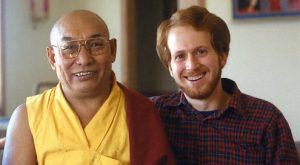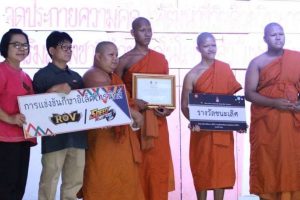
The sun has barely touched the green hill of Druk Amitabha to the west of Kathmandu, Nepal, and already the paths to the nunnery resound with the deep reverberation of a drum, pervading the entire space leading up to Naro Hall. The training starts at precisely 6 a.m. in the immense gymnasium overlooking the nunnery. In the hall, around 30 nuns positioned in straight lines diligently practice kung fu to the beat of the drum, their movements punctuated by small cries as the energy releases with each thrust. They train mainly in the kung fu style of China’s Shaolin Temple which, according to legend, was taught to the monks by the founder of the Chan school, Bodhidharma (act. 5th/6th century).
Wearing a tight outfit that enables them to move freely, with the front leg bent and the other stretched back— the dingdan position—they kick the air again and again, executing series upon series of impeccable moves. Now, with both legs bent outward to the maximum—the chumidan position—they diligently perform a series of hand movements, which results in a jerky but skillfully executed ballet: hands stretched out, the palms seeming to push the air away; fingers clawed towards the chest; fists punching the air in front or pressing against their sides; hands reaching up to touch the sky. . . An incredible energy can be felt from the subtle balance of these moves.
Every day, these nuns from the Drukpa Kagyu lineage of Tibetan Buddhism practice like this for two hours, tirelessly repeating the various movements taught by their teacher Jigme Rigzang, who lives in Vietnam and comes to Nepal to give teachings twice a year. During his visits, the nuns have three training sessions a day, which means six hours of intensive practice.

One hundred and eight nuns out of the three hundred and fifty who live at Druk Amitabha are devoted to this Chinese martial art. When their teacher considers them ready, the nuns also learn how to handle the traditional weapons used in kung fu: the sword (ki am), the saber (small dao), the halberd (big dao), the lance (tong), the stick, and the chain attached to two metallic bars (nhi khuc or nunchaku); they also use the “fan,” which is a much more aesthetic, dance-like practice.
The association of such sweet-looking nuns with this martial art is really quite a surprise. Who originated such a training? In fact, it was His Holiness the Gyalwang Drukpa, the 12th incarnation of the founder of the Dragon lineage (Druk is the Tibetan word for “dragon”), who wanted the nuns of his lineage to practice kung fu. That was in 2009. “My karma is to take care of women and of nuns,” His Holiness declared. “In our culture, no matter what they do, they are always second to men. I am fighting this attitude.” “You should know,” a 22-year-old nun named Jigme Mingyur, who is an expert in swordsmanship, explains to me, “that long ago the Shaolin monks, after being repeatedly harassed by thieves during their retreats, learned kung fu to protect themselves and save their lives.” “It is useful to us as women,” adds Jigme Wangchuk. Barely 16, she has already been practicing for three years, and is fully trained in eight different types of kung fu. “We feel safer when we have to go downtown or shopping on our own.”

Beyond the self-defense aspect, kung fu helps develop self-confidence, mitigating the shyness which afflicts many of the young nuns. Now, they are no longer afraid to speak up for themselves. It also helps to foster the ability to take on responsibilities both within the community and on the outside, in a society where it is still considered more auspicious to have been born a boy than a girl. “This is why we are proud to practice kung fu,” Jigme Wangchuk whispers with a smile. “His Holiness thinks that we can be as successful as men. If we do our utmost, everything is possible.” With this confidence, the nuns will be able to take a more active role in the world. His Holiness has initiated many projects in which the nuns are encouraged to participate, under the umbrella “Buddhism in
Action.” Among them are an ophthalmological clinic in Kathmandu and the White Lotus School and various tree-planting projects in Ladakh, as well as the “Eco Pad Yatra” (see the article by Naushin Ahmed on this website).

All the nuns agree that, above all, the martial art has been good for their health, helping them to strengthen their muscles, bones, and joints, and to remain fit. “As a consequence, we can sit in meditation or do our practices for longer periods of time,” Jigme Wangchuk declares. The young women also mention the benefits obtained in terms of concentration, which then helps them in their meditation practice. Jigme Kunchok—barely 20 and with five years of kung fu under her belt already—explains the process: “My eyes, my mind, follow the movements of my body. I need to be constantly aware of my movements, to know whether they are right or not, and to correct them immediately if necessary. Then I have to think of the next step right away, and so on . . . I must focus my attention on the sequence of movements I have memorized and on each movement at the same time. If the mind wanders, then the movement is not right or the stick falls . . .”

Focusing the attention is synonymous with being fully present in each moment, leading eventually to full self-awareness, both of which are steps on the path to enlightenment. Jigme Yeshe adds: “After two hours of kung fu practice, I don’t feel tired any more, I feel fresher, and I am able to concentrate better when I meditate.”
The nuns’ humility, coupled with their wholehearted enthusiasm, is readily apparent. In their productive lives, inner concentration and dedication to all sentient beings converge in an awareness of each and every moment.
*In the Drukpa lineage, the name given when taking Refuge is always preceded by “Jigme,” which means “fearless.”
Olivier Adam is a member of Dharma Eye–The Buddhist Photographer collective. To learn more about Dharma Eye and Olivier’s work as a photographer, visit: www.dharmaeye.com.













